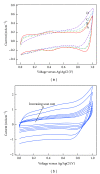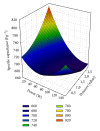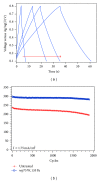Water plasma functionalized CNTs/MnO2 composites for supercapacitors
- PMID: 24348189
- PMCID: PMC3853549
- DOI: 10.1155/2013/832581
Water plasma functionalized CNTs/MnO2 composites for supercapacitors
Abstract
A water plasma treatment applied to vertically-aligned multiwall carbon nanotubes (CNTs) synthesized by plasma enhanced chemical vapour deposition gives rise to surface functionalization and purification of the CNTs, along with an improvement of their electrochemical properties. Additional increase of their charge storage capability is achieved by anodic deposition of manganese dioxide lining the surface of plasma-treated nanotubes. The morphology (nanoflower, layer, or needle-like structure) and oxidation state of manganese oxide depend on the voltage window applied during charge-discharge measurements and are found to be key points for improved efficiency of capacitor devices. MnO2/CNTs nanocomposites exhibit an increase in their specific capacitance from 678 Fg(-1), for untreated CNTs, up to 750 Fg(-1), for water plasma-treated CNTs.
Figures







Similar articles
-
DNA-assisted assembly of carbon nanotubes and MnO2 nanospheres as electrodes for high-performance asymmetric supercapacitors.Phys Chem Chem Phys. 2014 Mar 14;16(10):4672-8. doi: 10.1039/c3cp54911a. Phys Chem Chem Phys. 2014. PMID: 24469241
-
Graphene oxide-dispersed pristine CNTs support for MnO2 nanorods as high performance supercapacitor electrodes.ChemSusChem. 2013 Mar;6(3):474-80. doi: 10.1002/cssc.201200709. Epub 2013 Feb 18. ChemSusChem. 2013. PMID: 23417925
-
Synthesis of flake-like MnO2/CNT composite nanotubes and their applications in electrochemical capacitors.J Nanosci Nanotechnol. 2011 Mar;11(3):1996-2002. doi: 10.1166/jnn.2011.3539. J Nanosci Nanotechnol. 2011. PMID: 21449339
-
Carbon nanotube-wastewater treatment nexus: Where are we heading to?Environ Res. 2023 Dec 1;238(Pt 1):117088. doi: 10.1016/j.envres.2023.117088. Epub 2023 Sep 6. Environ Res. 2023. PMID: 37683781 Review.
-
Improving the air quality with Functionalized Carbon Nanotubes: Sensing and remediation applications in the real world.Chemosphere. 2022 Jul;299:134468. doi: 10.1016/j.chemosphere.2022.134468. Epub 2022 Mar 29. Chemosphere. 2022. PMID: 35364076 Review.
Cited by
-
Super-Capacitive Performance of Manganese Dioxide/Graphene Nano-Walls Electrodes Deposited on Stainless Steel Current Collectors.Materials (Basel). 2019 Feb 4;12(3):483. doi: 10.3390/ma12030483. Materials (Basel). 2019. PMID: 30720766 Free PMC article.
References
-
- Conway BE. Electrochemical Supercapacitors; Scientific Fundamentals and Technological Applications. New York, NY, USA: Kluwer Academic/ Plenum Publishers; 1999.
-
- Okajima K, Ohta K, Sudoh M. Capacitance behavior of activated carbon fibers with oxygen-plasma treatment. Electrochimica Acta. 2005;50(11):2227–2231.
-
- Pandolfo AG, Hollenkamp AF. Carbon properties and their role in supercapacitors. Journal of Power Sources. 2006;157(1):11–27.
-
- Amade R, Jover E, Caglar B, Mutlu T, Bertran E. Optimization of MnO2/vertically aligned carbon nanotube composite for supercapacitor application. Journal of Power Sources. 2011;196(13):5779–5783.
-
- Lota G, Lota K, Frackowiak E. Nanotubes based composites rich in nitrogen for supercapacitor application. Electrochemistry Communications. 2007;9(7):1828–1832.
Publication types
MeSH terms
Substances
LinkOut - more resources
Full Text Sources
Other Literature Sources

